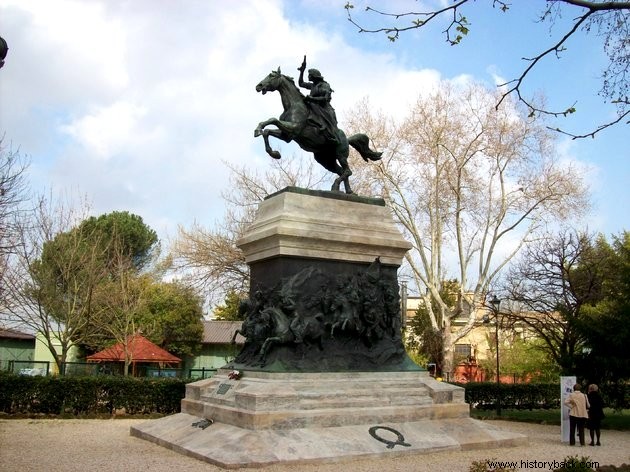Anita Garibaldi (1821-1849), born Ana Maria de Jesus Ribeiro da Silva, was a Brazilian revolutionary who fought for the republic in Brazil and the unification of Italy.
Biography of Anita Garibaldi
Anita Garibaldi was born in the city of Laguna (SC), in 1821, and was the daughter of a merchant. At age 14, after her father's death, she marries a shoemaker, but the marriage only lasts three years.
Her husband would enlist in the imperial troops, while Anita's family supported the farroupilhas (or farrapos) who wanted to separate from the Empire of Brazil.
At the age of 18, she meets the Italian guerrilla Giuseppe Garibaldi, and for him, she would leave her husband. In this way, we can see that Anita did not accept being subjected to the norms of society.
Giuseppe Garibaldi came to America because of his involvement with the struggles for the unification of Italy and had been sentenced to death for conspiracy by the Kingdom of Sardinia (present-day Italy). 
After a stay in Rio de Janeiro, he joined the troops of David Canabarro (1796-1867) and conquered Laguna, on July 20, 1839. His boat had sunk and he spent his days on board observing the city with his spyglass. Suddenly, he came across a young woman who caught his attention for her beauty.
On land she became acquainted with a local and he invited him to his house. The first person he was introduced to was his niece, who coincidentally, was the young woman he had seen from the ship.
Years later, he would remember in detail the first meeting between the two:
Next to Garibaldi, Anita would fight the imperial troops. She received her baptism of fire when the boat was attacked by the Imperial Navy in 1839, where she utilized the carbine to defend herself.
Anita Garibaldi would participate in the fight leading columns on the march, organizing a hospital to care for the wounded and also fighting in battles.
When the Farrapos were defeated in Santa Catarina, the couple decided to go to Uruguay, the only country at the time that accepted divorce and that had recognized the Rio Grande do Sul Republic.
Leading a herd of 900 cattle, Garibaldi and Anita settle in Montevideo, where they get married in 1842 and have three more children. They would live in the Uruguayan capital from 1841 to 1848.
Garibaldi was made commander of the Navy in Uruguay and would lead the Italian Legion formed by exiled compatriots. The mark of this troop was the use of red shirts and that's how they would become known.
Giuseppe Garibaldi had never forgotten his homeland, nor the struggles that took place there. So he sends his wife and three children to Nizza (now Nice, France) to prepare for his arrival. He is elected deputy in Rome in 1849 and gets involved again in the struggle for the unification of the Italian peninsula.
However, Anita refuses to stay at home and goes to meet her husband to fight alongside her against the Austrians and French. In 1849, Garibaldi's troops are defeated by the French in Rome and Giuseppe and Anita retreat. Anita refuses to leave him and goes with him, despite being sick.
Anita Garibaldi died at the age of 28, in 1849, pregnant with her fifth child. She was buried seven times, four for political reasons. As for Garibaldi, he would be victorious in the wars of the Unification of Italy and considered one of its founders.
Anita and Giuseppe Garibaldi had four children and three reached adulthood. Anita Garibaldi's remains rest in a monument inaugurated in 1932 by Benito Mussolini, in Rome.
Historical Context
Anita Garibaldi's life must be understood within the context of the Regency Period (1831-1840) when several Brazilian provinces took advantage of the lack of a strong authority to separate themselves from the Empire of Brazil.
The southern provinces, Santa Catarina and Rio Grande do Sul, wage the War of the Farrapos. At this time, two independent countries were founded for a short period:the Rio Grande do Sul Republic (1838-1845) and the Juliana Republic (1839).
On the other hand, in the Italian peninsula began the process that would culminate in the Italian Unification. The Italian peninsula was a mosaic of kingdoms, the north was occupied by the Austrians and still had the Papal States that were defended by French troops.

Thus, there were not few volunteers like the sailor Giuseppe Garibaldi, who joined the troops of Piedmont, where the Savoy dynasty reigned, in order to unify the peninsula.
However, Garibaldi fell out with the king, who sentenced him to death. In this way, Garibaldi flees to South America, where he will fight alongside the republicans against the Empire of Brazil. And in this way, her path will cross that of the young Ana Maria who will go down in history as Anita Garibaldi, the "Heroine of the Two Worlds".
Fun facts about Anita Garibaldi
- The house where Anita Garibaldi lived in Laguna is now a museum, opened in 1978 and tells the story of the illustrious resident.
- The municipality of Anita Garibaldi, elevated to the status of city in 1961, is so named because Anita passed through there in 1842 when the place was just a resting point for the troops.
- Anita Garibaldi was the theme of the samba school Viradouro in 1999 with the theme “Anita Garibaldi - a Heroína das Sete Magias”.
- Her life has been brought to the big screen in several Italian and Brazilian films “Anita and Garibaldi ”, by Alberto Rondalli, 2013.
- Because of her importance in Brazilian history, Anita Garibaldi names avenues, streets and schools throughout Brazil. In 2012, the Anita Garibaldi bridge was opened over Lagoa do Imaruí, connecting the city of Laguna to the mainland.
